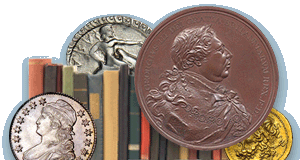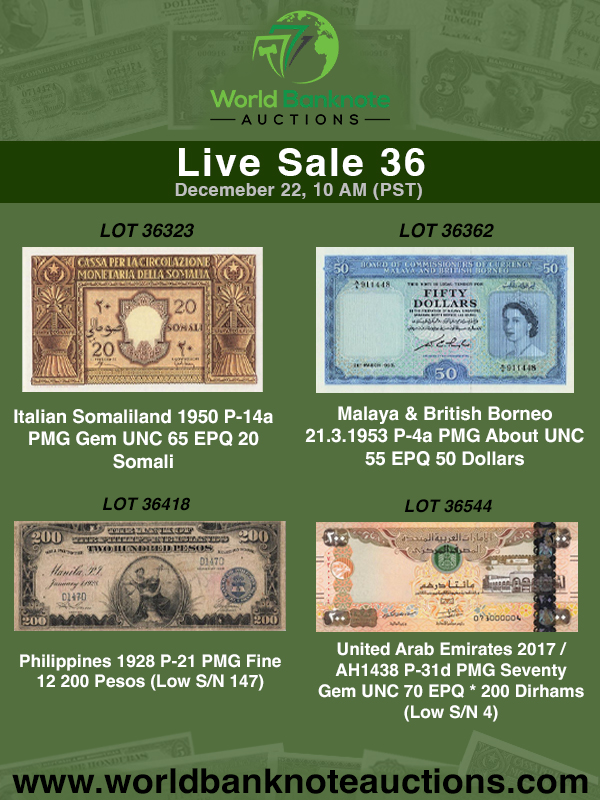
PREV ARTICLE
NEXT ARTICLE
FULL ISSUE
PREV FULL ISSUE
V25 2022 INDEX E-SYLUM ARCHIVE VOCABULARY TERM: MEDALLIC ARTHere's another entry from Dick Johnson's Encyclopedia of Coin and Medal Terminology. -Editor Medallic Art. A class of art that can reproduce bas-relief images, often including lettering, expressed as medals, medallions, plaquettes or similar objects. Because of the similarity of manufacture, medallic art could also include coins, but this is more aptly termed numismatic art (as it is in this book). Medallic art may be included in the class of glyptic art, which also includes engraved objects like gems, seals and cameos (only some of which are included in this book – those that are, or can be, reproduced). Medallic art includes small bas-relief objects made from patterns created by one of several sculpture methods: some by casting from an exact size pattern, or, from an oversize model that is pantographically reduced – this process cuts a die to strike the item – or even hand engraving is used to make or refine the pattern. These are then reproduced in quantity, by casting or striking. Medallic art characteristics. Exemplified by art medals medallic art is created by artists rather than coining technicians. The medallic artist has at his disposal a palette of techniques for medallic creations differing greatly from those of the coin artist. In addition to its design (in a wide range of styles), the medallic artist employs height of relief, texture of the surfaces, and an expanded use of symbols and symbology. He also has a far greater determination of the item's shape, whether it has openwork, and its finish or patina, among dozens of other characteristics (all discussed in this book). These are all techniques available to the medallic artist. Medallic art is a field of art unlike any other. It has the recognized ability to commemorate, memorialize, document, or honor a person, place or event. It creates objects that are capable of recording such pictures with captions as miniature works of art. Better yet, these highly desirable objects last forever. Like coins and numismatic art, medals and medallic art are also noted for their longevity: one generation talking to another generation many years or centuries apart, in a very artistic manner. Medallic art is very close to sculpture, because of its three dimensionality. It also has a heritage or outgrowth based on engraving and diesinking – hand engraving at first – but machine engraving as the field progressed (and machine engraving requires a sculptor's model). While it is a marriage of art to coining, medallic art is also an art medium that is very democratic: anyone can have a medal made! Or, by individual casting, anyone can make their own medal. Numismatic art versus medallic art. The art work – designs, models and patterns – for coins have many more restrictions than the art work required for medallic items. The coindesigner must keep in mind dozens of these limitations when preparing a new coindesign. A coin must be a certain size, have a prescribed weight, must be an exact shape (most often round), have a denomination, bear required mottoes or other lettering, the height of relief is extremely limited, it must adhere to the laws of coinability, if must be suitable for vending machines, it must bear a nationalistic design and be recognizable by its citizens, it must have a certain propriety, the die to strike it must have a certain camber (and a basin in its model), it must not have congruent mass (heavy areas of relief back-to-back), its surface must have a certain resistivity to trigger fare box and turnstiles. The list appears endless. Medallic art has none of these restrictions. Medallic art can be created for anyone – not just for a nation – thus being far more democratic. Medallic art can be freer and liberated in its design and conception! A medal can picture and its inscriptions can say virtually what its issuer wants (short of slandering a living person). It is a miniature work of art to commemorate, to memorialize, to celebrate, to preserve an image -- of a person, thing or event -- for future generations. Medallic art has great longevity. As an art object it is far more apt to be saved, preserved, venerated by succeeding generations. A special class of medallic art – MEDALLIC OBJECTS – goes even further in this discarding of restrictions. Medallic objects, created only within the last few decades, purposely break the rules of coin and medaldesign, overcome medallic prejudice in addition to all technical restraint, to become aesthetic objects for the eye to behold. Medallic art practitioners. The greatest practitioners of medallic art has always been the French. The Paris Mint must be celebrated for their support and encouragement of this field. They have issued, even when it was not politically correct or economic to do so, hundreds of fine art medals each year. Not only have they issued art medals created by their own countrymen, but also from fine art medalists from around the world. This support reached a pinnacle under the direction of Mint Director Pierre de Haye. In the 1960s during his administration he was issuing, on average, one new art medal a day. Subjects covered the spectrum of man's endeavor, styles were as broad as the hundreds of artist's work he was producing. To his credit, and a few inspired artists, they even developed a new art medium, the medallic object.
Collecting medallic art. Highly artistic medal collecting parallels that of medal collecting in general. Collectors seek specimens that can be included in their chosen topic that serves as a guide for their collecting. However, since Medallic Art Company. A company by this name was active in the 20th century in America. Incorporated in New York City in 1910, Medallic Art Company rose from a workroom for a sculptors' assistant, Henri Weil, who had imported the first Janvier to America (for a previous employer, Deitsch Brothers, that produced medals 1907-1910). With his brother, Felix Weil, they built the business, along with a third associate who joined them in 1919, Clyde Curlee Trees. This firm struck the major art medals in America from the first World War forwards. This firm also created the most prestigious award medals including the Pulitzer Medal for journalism, the George Foster Peabody Medal for broadcasting, the National Medal of Science, the Presidential Medal for Freedom, the Congressional Medal of Honor, and the Newberry and Caldecott Medals in the field of literature. Also they were dominant in the private manufacture of official U.S. presidential inaugural medals. In 1930 it further supported the medallic field by sponsoring The Society of Medalists, which issued two art medals a year spawned by famed American sculptors. In 1972 the firm moved from New York City to Danbury, Connecticut, in time to satisfy the tremendous demand for bicentennial medals. (The present author was director of research for the firm at this time.) A decade after the dropoff of business, following the American bicentennial, the assets of the firm were purchased by Tri State Minting, moved to Sioux Falls, South Dakota, and ultimately removed to Dayton, Nevada in 1997. Development of A Theme. Daniel Chester French was commissioned to prepare the Catskill Aqueduct Medal in 1922. He chose a female head as his theme and modeled it in classical style. He included a border of dentiles that further emphasized the classical treatment. It was sponsored by the American Numismatic Society (to their credit!) and issued in three-inch cast size in bronze and silver. It was also struck in dollar size 1 1/2-inch bronze and silver and became a so-called dollar.
In 1933 the president of Medallic Art Company, which had produced the medal, Clyde Curlee Trees, chose the female head from the obverse of this medal to become his company's trademark. He eliminated the classical border of dentiles but kept the female head intact. He ordered dies made in five different sizes (without the border) and the design became famous for its appearance in advertising, stationery, nameplates, business cards, even as a mintmark (first used by the firm in 1968). In honor of its creator, Daniel Chester French, the trademark became known as the
References:
To read the complete entry on the Newman Numismatic Portal, see:
Wayne Homren, Editor The Numismatic Bibliomania Society is a non-profit organization promoting numismatic literature. See our web site at coinbooks.org. To submit items for publication in The E-Sylum, write to the Editor at this address: whomren@gmail.com To subscribe go to: https://my.binhost.com/lists/listinfo/esylum All Rights Reserved. NBS Home Page Contact the NBS webmaster 
|
